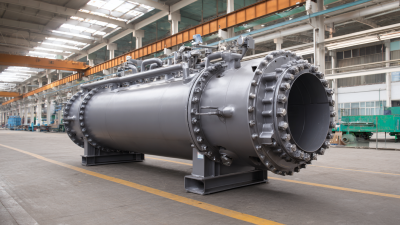Leave Your Message
In the quest for enhanced operational efficiency, industries are increasingly turning to innovative thermal management solutions, among which PHE heat exchangers stand out as a transformative technology. According to a report by MarketsandMarkets, the global heat exchanger market is projected to reach $22.40 billion by 2026, with a significant share driven by the adoption of PHE heat exchangers due to their superior performance and energy savings. These devices, characterized by their compact design and increased heat transfer efficiency, allow for significant reductions in energy consumption and operational costs. Furthermore, the versatility of PHE heat exchangers enables their application across various sectors, including chemical processing, pharmaceuticals, and food and beverage, validating their role in optimizing thermal management systems. As industries continue to pursue sustainability and efficiency, PHE heat exchangers may indeed hold the key to revolutionizing thermal processes and achieving competitive advantage in today's demanding market.

Plate Heat Exchangers (PHE) have transformed thermal management across various industries by providing enhanced efficiency and versatility. One of the primary benefits of PHE heat exchangers is their compact design, which allows for a significant reduction in space requirements compared to traditional shell-and-tube heat exchangers. This space-saving feature makes PHE ideal for plants with limited footprint, enabling efficient integration into existing systems.
Moreover, PHE heat exchangers offer superior thermal performance due to their large surface area and improved flow channels. This results in better heat transfer rates while requiring less energy input, ultimately leading to cost savings. Industries such as food processing, chemical manufacturing, and HVAC systems have increasingly adopted PHE technology to improve their energy efficiency and reduce operating costs.
Tips: When selecting a PHE, consider the specific thermal requirements of your application. Ensure the materials are compatible with the fluids being processed to avoid corrosion or fouling. Regular maintenance checks can also help prolong the lifespan of your heat exchangers, ensuring optimal performance throughout their operation.
PHE heat exchangers, or plate heat exchangers, have become essential in modern industrial applications due to their unique design and efficiency in thermal management. One of their key features is the compactness, which allows for a high heat transfer area in a smaller footprint compared to traditional shell-and-tube exchangers. This design not only saves valuable floor space but also reduces the overall materials used, making them a more sustainable choice for businesses looking to optimize their operations.
Another standout characteristic is their exceptional versatility. PHE heat exchangers can accommodate a wide range of fluids and thermal conditions, allowing industries to tailor their cooling or heating processes to specific requirements. This flexibility is complemented by the ease of maintenance they offer; their modular design allows for simple disassembly and cleaning, minimizing downtime and ensuring continuous operational efficiency. In addition, the ability to expand or reduce the number of plates makes them highly adaptable for changing production demands, further enhancing their appeal in a fast-paced industrial environment.

To optimize the efficiency of Plate Heat Exchangers (PHE), it is essential to focus on proper maintenance and operational parameters. Regular cleaning of the plates is crucial, as build-up of fouling materials can significantly hinder heat transfer efficiency. Implementing a scheduled cleaning routine will not only improve performance but also extend the lifespan of the equipment. Utilizing specialized cleaning agents designed for PHEs can enhance the effectiveness of this process, ensuring that the heat exchanger operates at peak efficiency.
Moreover, monitoring the flow rates and temperatures on both the hot and cold sides of the exchanger is vital. Balancing these parameters can prevent thermal imbalance and help maintain optimal thermal performance. It is also important to ensure that PHEs are appropriately sized for their intended applications. Oversizing can lead to reduced pressure drops and inefficient heat transfer, while undersizing may cause excessive pressure drops and operational stress. By carefully analyzing and adjusting these factors, industries can unlock the full potential of their PHE systems, resulting in improved energy efficiency and reduced operational costs.
PHE (Plate Heat Exchanger) heat exchangers are transforming thermal management across various industries. Their compact design and high efficiency make them perfect for a range of applications, including food and beverage processing, HVAC systems, and chemical engineering. In food and beverage industries, PHEs aid in pasteurization and cooling processes, ensuring that products not only maintain their quality but also comply with health standards. In HVAC systems, they contribute to energy savings while maintaining desired indoor climate conditions.
**Tips for Using PHE Heat Exchangers:**
When selecting a PHE, consider the specific thermal loads and the process fluid characteristics to ensure optimal performance. Regular maintenance is crucial for keeping the heat exchanger functioning efficiently; timely cleaning can prevent fouling and prolong equipment life. Additionally, monitor the temperature and pressure differentials during operation to identify any potential issues before they lead to system failures.
In chemical processing, PHEs are employed for heating and cooling reactions, providing precise temperature control essential for product quality. Their adaptability and effectiveness in handling various fluids make them a sought-after solution in the industry. As industries continue to prioritize efficiency and sustainability, PHE heat exchangers will undoubtedly play a pivotal role in enhancing thermal management practices.
| Industry | Common Applications | Benefits of PHE | Typical Temperature Range (°C) |
|---|---|---|---|
| Chemical Processing | Heating and cooling of process fluids | High efficiency, compact design | -20 to 250 |
| Food and Beverage | Pasteurization, chilling | Hygienic design, energy savings | 0 to 100 |
| HVAC | Heat recovery, cooling systems | Compact, adaptable to various configurations | -10 to 90 |
| Pharmaceuticals | Temperature control for reactors | Precise temperature management, efficiency | -10 to 180 |
| Marine | Cooling of engines and auxiliary systems | Robustness, space saving | 0 to 80 |
In recent years, the heat exchanger industry has seen significant advancements aimed at enhancing performance and efficiency. According to a report by Markets and Markets, the global market for heat exchangers is projected to grow from $14.1 billion in 2021 to $20.1 billion by 2026, at a compound annual growth rate (CAGR) of 7.5%. This growth is largely driven by the increasing demand for energy-efficient thermal management solutions across various sectors, including chemical processing, HVAC, and power generation.
Future trends in heat exchanger technology focus heavily on improving heat transfer efficiency and operational reliability. Innovations such as compact heat exchangers, which occupy less space while providing superior thermal performance, are becoming increasingly popular. Additionally, the integration of advanced materials, such as graphene and carbon nanotubes, shows potential for enhancing thermal conductivity and corrosion resistance. A study by Frost & Sullivan indicates that the adoption of these new materials could lead to a 30% increase in overall efficiency compared to traditional designs. As industries continue to prioritize sustainability and energy conservation, these advancements promise to play a crucial role in revolutionizing thermal management practices.







